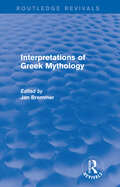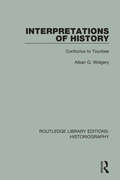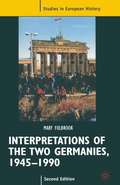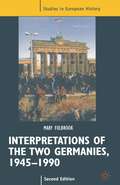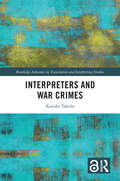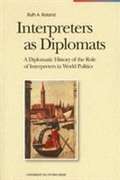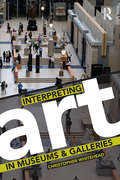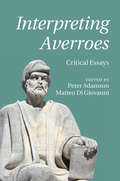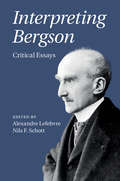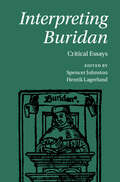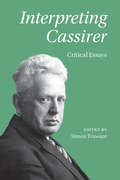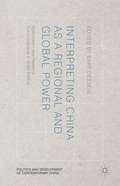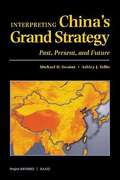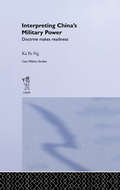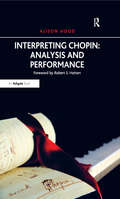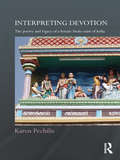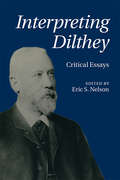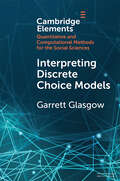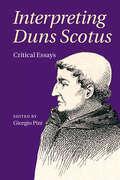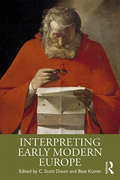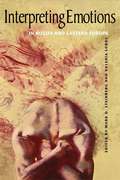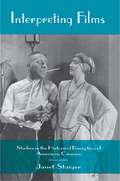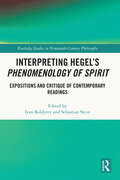- Table View
- List View
Interpretations of Greek Mythology (Routledge Revivals)
by Jan N. BremmerInterpretations of Greek Mythology, first published in1987, builds on the innovative work of Walter Burkert and the ‘Paris school’ of Jean-Pierre Vernant, and represents a renewal of interpretation of Greek mythology. The contributors to this volume present a variety of approaches to the Greek myths, all of which eschew a monolithic or exclusively structuralist hermeneutic method. Specifically, the notion that mythology can simply be read as a primitive mode of narrative history is rejected, with emphasis instead being placed on the relationships between mythology and history, ritual and political genealogy. The essays concentrate on some of the best known characters and themes – Oedipus, Orpheus, Narcissus – reflecting the complexity and fascination of the Greek imagination. The volume will long remain an indispensable tool for the study of Greek mythology, and it is of great interest to anyone interested in the development of Greek culture and civilisation and the nature of myth.
Interpretations of History: From Confucius to Toynbee (Routledge Library Editions: Historiography)
by Alban G. WidgeryIn this volume, originally published in 1961, the author presents an exposition of the meanings given to history. Part 1 describes the conceptions of history impied in wide-spread religions and cultures, Confucian and Taoist, Hindu and Buddhist, Zoroastrian and Muslim, Greek and Roman, Jewish and Christian. Part 2 surveys the theories of independent thinkers and schools in the Occident from the Middle Ages to the mid-twentieth century.
Interpretations of the Two Germanies
by Mary FulbrookThe two Germanies, arising from the unpromising ashes of defeated Nazi Germany, came to represent opposing models of state and society. The Federal Republic established itself as a remarkably stable democracy and successful social market economy: the German Democratic Republic developed an apparently exemplary form of 'actually existing socialism' and became a pillar of the Soviet bloc. Then in 1989, the 'gentle revolution' in East Germany added a new twist with the collapse of Communist rule. With rapid reunification, the united Germany of 1990 faced new challenges as the unprecedented transformation created a multitude of economic problems and social tensions. Previously published in 1992 as The Two Germanies, this book has been fully revised and updated to take account of all the latest developments in contemporary German history.
Interpretations of the Two Germanies, 1945-1990: Problems Of Interpretation (Studies in European History)
by Mary FulbrookThe two Germanies, arising from the unpromising ashes of defeated Nazi Germany, came to represent opposing models of state and society. The Federal Republic established itself as a remarkably stable democracy and successful social market economy: the German Democratic Republic developed an apparently exemplary form of 'actually existing socialism' and became a pillar of the Soviet bloc. Then in 1989, the 'gentle revolution' in East Germany added a new twist with the collapse of Communist rule. With rapid reunification, the united Germany of 1990 faced new challenges as the unprecedented transformation created a multitude of economic problems and social tensions.Previously published in 1992 as The Two Germanies, this book has been fully revised and updated to take account of all the latest developments in contemporary German history.
Interpreters and War Crimes (Routledge Advances in Translation and Interpreting Studies)
by Kayoko TakedaTaking an interdisciplinary approach, this book raises new questions and provides different perspectives on the roles, responsibilities, ethics and protection of interpreters in war while investigating the substance and agents of Japanese war crimes and legal aspects of interpreters’ taking part in war crimes. Informed by studies on interpreter ethics in conflict, historical studies of Japanese war crimes and legal discussion on individual liability in war crimes, Takeda provides a detailed description and analysis of the 39 interpreter defendants and interpreters as witnesses of war crimes at British military trials against the Japanese in the aftermath of the Pacific War, and tackles ethical and legal issues of various risks faced by interpreters in violent conflict. The book first discusses the backgrounds, recruitment and wartime activities of the accused interpreters at British military trials in addition to the charges they faced, the defence arguments and the verdicts they received at the trials, with attention to why so many of the accused were Taiwanese and foreign-born Japanese. Takeda provides a contextualized discussion, focusing on the Japanese military’s specific linguistic needs in its occupied areas in Southeast Asia and the attributes of interpreters who could meet such needs. In the theoretical examination of the issues that emerge, the focus is placed on interpreters’ proximity to danger, visibility and perceived authorship of speech, legal responsibility in war crimes and ethical issues in testifying as eyewitnesses of criminal acts in violent hostilities. Takeda critically examines prior literature on the roles of interpreters in conflict and ethical concerns such as interpreter neutrality and confidentiality, drawing on legal discussion of the ineffectiveness of the superior orders defence and modes of individual liability in war crimes. The book seeks to promote intersectoral discussion on how interpreters can be protected from exposure to manifestly unlawful acts such as torture.
Interpreters as Diplomats: A Diplomatic History of the Role of Interpreters in World Politics
by Ruth A. RolandThis book looks at the role played throughout history by translators and interpreters in international relations. It considers how political linguistics function and have functioned throughout history.
Interpreting Ancient Figurines
by Richard G. LesureThis book examines ancient figurines from several world areas to address recurring challenges in the interpretation of prehistoric art. Sometimes figurines from one context are perceived to resemble those from another. Richard G. Lesure asks whether such resemblances play a role in our interpretations. Early interpreters seized on the idea that figurines were recurringly female and constructed the fanciful myth of a primordial Neolithic Goddess. Contemporary practice instead rejects interpretive leaps across contexts. Dr. Lesure offers a middle path: a new framework for assessing the relevance of particular comparisons. He develops the argument in case studies that consider figurines from Paleolithic Europe, the Neolithic Near East, and Formative Mesoamerica.
Interpreting Art in Museums and Galleries
by Christopher WhiteheadIn this pioneering book, Christopher Whitehead provides an overview and critique of art interpretation practices in museums and galleries. Covering the philosophy and sociology of art, traditions in art history and art display, the psychology of the aesthetic experience and ideas about learning and communication, Whitehead advances major theoretical frameworks for understanding interpretation from curators’ and visitors’ perspectives. Although not a manual, the book is deeply practical. It presents extensively researched European and North American case studies involving interviews with professionals engaged in significant cutting-edge interpretation projects. Finally, it sets out the ethical and political responsibilities of institutions and professionals engaged in art interpretation. Exploring the theoretical and practical dimensions of art interpretation in accessible language, this book covers: The construction of art by museums and galleries, in the form of collections, displays, exhibition and discourse; The historical and political dimensions of art interpretation; The functioning of narrative, categories and chronologies in art displays; Practices, discourses and problems surrounding the interpretation of historical and contemporary art; Visitor experiences and questions of authorship and accessibility; The role of exhibition texts, new interpretive technologies and live interpretation in art museum and gallery contexts. Thoroughly researched with immediately practical applications, Interpreting Art in Museums and Galleries will inform the practices of art curators and those studying the subject.
Interpreting Averroes: Critical Essays
by Peter Adamson Matteo Di GiovanniThis volume brings together world-leading scholars on the thought of Averroes, the greatest medieval commentator on Aristotle but also a major scholar of Islam. The collection situates him in his historical context by emphasizing the way that he responded to the political situation of twelfth-century Islamic Spain and the provocations of Islamic theology. It also sheds light on the interconnections between aspects of his work that are usually studied separately, such as his treatises on logic and his legal writings. Advanced students and scholars will find authoritative and insightful treatments of Averroes' philosophy, tackled from multiple perspectives and written in a clear and accessible way that will appeal to those encountering his work for the first time as well as to anyone looking for new critical approaches to Averroes and his thinking.
Interpreting Avicenna
by Peter AdamsonAvicenna is the greatest philosopher of the Islamic world. His immense impact on Christian and Jewish medieval thought, as well as on the subsequent Islamic tradition, is charted in this volume alongside studies which provide a comprehensive introduction to and analysis of his philosophy. Contributions from leading scholars address a wide range of topics including Avicenna's life and works, conception of philosophy and achievement in logic and medicine. His ideas in the main areas of philosophy, such as epistemology, philosophy of religion and physics, are also analyzed. While serving as a general introduction to Avicenna's thought, this collection of critical essays also represents the cutting edge of scholarship on this most influential philosopher of the medieval era.
Interpreting Bergson: Critical Essays
by Alexandre Lefebvre Nils F. SchottBergson was a pre-eminent European philosopher of the early twentieth century and his work covers all major branches of philosophy. This volume of essays is the first collection in twenty years in English to address the whole of Bergson's philosophy, including his metaphysics, epistemology, philosophy of science, philosophy of life, aesthetics, ethics, social and political thought, and religion. The essays explore Bergson's influence on a number of different fields, and also extend his thought to pressing issues of our time, including philosophy as a way of life, inclusion and exclusion in politics, ecology, the philosophy of race and discrimination, and religion and its enduring appeal. The volume will be valuable for all who are interested in this important thinker and his continuing relevance.
Interpreting Buridan: Critical Essays
by Henrik Lagerlund Spencer JohnstonJohn Buridan (d. 1362) is one of the great thinkers of the later Middle Ages. He is perhaps best known for his contributions to logic, but the range of his thought is wide. This volume of new essays, written by leading Buridan scholars, places Buridan in his philosophical context and examines his writings on logic, modal logic, paradoxes, metaphysics, epistemology, and natural philosophy. It also introduces several new topics of discussion that have not so far been dealt with in scholarship on Buridan, such as his theory of knowledge, his view of artefacts, his conception of women, his writing on emotions, and his moral philosophy. Together the essays produce a rich picture of Buridan's thought and underline the continuing relevance of his philosophical concerns.
Interpreting Cassirer: Critical Essays
by Simon TruwantThis is the first comprehensive volume in English on Cassirer's philosophy for over seventy years. Eleven leading Cassirer scholars address all of the key aspects of Cassirer's multi-faceted thought and situate them in the wider context of his philosophy of culture. Their essays demonstrate the depth and richness of a philosophical enterprise that still awaits recognition as one of the most original contributions to twentieth-century philosophy. Interpreting Cassirer will prove invaluable not only for Cassirer scholars and researchers of early twentieth-century philosophy, but also for scholars of the philosophy of culture, language, science, art, history, and mind.
Interpreting China as a Regional and Global Power
by Bart DesseinUntil the 19th century, Confucian China was arguably the most important economic and political power in East and Southeast Asia. The fall of the Confucian empire in the early 20th century paved the way for the development of Chinese nationalism which was seen as the only means by which the country could regain its importance as a regional and global power. The changing position of contemporary China in the world and the revaluation of Confucianism combined with nationalist and patriotic tendencies, brings into question the role that historical consciousness plays in China's national and international identity. This important collection discusses the history of Chinese nationalism and the issue of traditionalism vs. modernity in Chinese political thinking, and investigates the geopolitical impact of China's rise in its immediately adjacent regions, as well as its functioning in organizations of global governance. It thus assesses China's contemporary national and international identity against the background of its Confucian and nationalist history.
Interpreting China's Grand Strategy: Past, Present, and Future
by Sara A. Daly Peter W. Greenwood Michael D. SwaineChina's continuing rapid economic growth and expanding involvement in global affairs pose major implications for the power structure of the international system. To more accurately and fully assess the significance of China's emergence for the United States and the global community, it is necessary to gain a more complete understanding of Chinese security thought and behavior. This study addresses such questions as: What are China's most fundamental national security objectives? How has the Chinese state employed force and diplomacy in the pursuit of these objectives over the centuries? What security strategy does China pursue today and how will it evolve in the future? The study asserts that Chinese history, the behavior of earlier rising powers, and the basic structure and logic of international power relations all suggest that, although a strong China will likely become more assertive globally, this possibility is unlikely to emerge before 2015-2020 at the earliest. To handle this situation, the study argues that the United States should adopt a policy of realistic engagement with China that combines efforts to pursue cooperation whenever possible; to prevent, if necessary, the acquisition by China of capabilities that would threaten America's core national security interests; and to remain prepared to cope with the consequences of a more assertive China.
Interpreting China's Military Power: Doctrine Makes Readiness (Cass Military Studies)
by Ka Po NgAlthough inter-state tensions have generally been easing after the Cold War, military power remains a dominant factor in Asian regional politics. As China, operating the world's largest army, grows stronger, there are ongoing debates over the implications for Asia's regional security. This book argues that it is imperative to look beyond the empirical observations and conventional materialist reading of Chinese military development to understand its dynamics and directions in doctrinal terms and put it in a readiness context for evaluation. Military doctrine has long been under-studied and is often treated as a subject separate from force development. But, as this study contends, this factor is necessary for interpreting the making and purposes of China's military power because it forms the intellectual foundation of military structural and hardware development. When loaded with political rhetoric, it also communicates to us the intended uses of the military power. The role of doctrine is reinforced in the context of military readiness, which defines what for and how the army is getting ready. Force development is evaluated in structural, operational and directional terms.The importance of this analytical framework based on military doctrine and readiness is demonstrated in a survey of the evolutionof Chinese military doctrine and force development. As the Chinese People's Liberation Army has continued to adjust its military structure and operation to follow the doctrinal lead, its switches between the doctines of local war and total war have seen corresponding changes to the emphasis between operational and structural readiness.
Interpreting Chopin: Analysis and Performance
by Alison HoodMusic theory is often seen as independent from - even antithetical to - performance. While music theory is an intellectual enterprise, performance requires an intuitive response to the music. But this binary opposition is a false one, which serves neither the theorist nor the performer. In Interpreting Chopin Alison Hood brings her experience as a performer to bear on contemporary analytical models. She combines significant aspects of current analytical approaches and applies that unique synthetic method to selected works by Chopin, casting new light on the composer’s preludes, nocturnes and barcarolle. An extension of Schenkerian analysis, the specific combination of five aspects distinguishes Hood’s method from previous analytical approaches. These five methods are: attention to the rhythms created by pitch events on all structural levels; a detailed accounting of the musical surface; 'strict use' of analytical notation, following guidelines offered by Steve Larson; a continual concern with what have been called 'strategies' or 'premises'; and an exploration of how recorded performances might be viewed in terms of analytical decisions, or might even shape those decisions. Building on the work of such authors as William Rothstein, Carl Schachter and John Rink, Hood’s approach to Chopin’s oeuvre raises interpretive questions of central interest to performers.
Interpreting Devotion: The Poetry and Legacy of a Female Bhakti Saint of India (Routledge Hindu Studies Series)
by Karen PechilisDevotion is a category of expression in many of the world’s religious traditions. This book looks at issues involved in academically interpreting religious devotion, as well as exploring the interpretations of religious devotion made by a sixth century poet, a twelfth century biographer, and present-day festival publics. The book focuses on the female poet-saint Kāraikkāl Ammaiyār, whose poetry is devotional in nature. It discusses the biography written on the poet six centuries after her lifetime, and suggests ways of interpreting Kāraikkāl Ammaiyār’s poetry without using the categories and events promoted by her biographer, in order to engage her own thoughts as they are communicated through the poetry attributed to her. In the same way that the biographer made the poet ‘speak’ to his present day, the book looks at how festivals held today make both the poetry and the biography relevant to the present day. By discussing how poetry, story and festival provide distinctive yet overlapping interpretations of the saint, this book reveals the selections and priorities of interpreters in the making of a living tradition. It is an accessible contribution to students and scholars of religion, Indian history and women’s studies.
Interpreting Dilthey: Critical Essays
by Eric S. NelsonIn this wide-ranging and authoritative volume, leading scholars engage with the philosophy and writings of Wilhelm Dilthey, a key figure in nineteenth-century thought. Their chapters cover his innovative philosophical strategies and explore how they can be understood in relation to their historical situation, as well as presenting incisive interpretations of Dilthey's arguments, including their development, their content, and their influence on later thought. A key focus is on how Dilthey's work remains relevant to current debates around art and literature, the biographical and autobiographical self, knowledge, language, science, culture, history, society, and psychology and the embodied mind. The volume will be important for researchers in hermeneutics, aesthetics, practical philosophy, and the history of German philosophy, providing a valuable introduction to Dilthey's work as well as detailed critical analysis of its ongoing significance.
Interpreting Discrete Choice Models (Elements in Quantitative and Computational Methods for the Social Sciences)
by Garrett GlasgowIn discrete choice models the relationships between the independent variables and the choice probabilities are nonlinear, depending on both the value of the particular independent variable being interpreted and the values of the other independent variables. Thus, interpreting the magnitude of the effects (the “substantive effects”) of the independent variables on choice behavior requires the use of additional interpretative techniques. Three common techniques for interpretation are described here: first differences, marginal effects and elasticities, and odds ratios. Concepts related to these techniques are also discussed, as well as methods to account for estimation uncertainty. Interpretation of binary logits, ordered logits, multinomial and conditional logits, and mixed discrete choice models such as mixed multinomial logits and random effects logits for panel data are covered in detail. The techniques discussed here are general, and can be applied to other models with discrete dependent variables which are not specifically described here.
Interpreting Duns Scotus: Critical Essays
by Giorgio PiniJohn Duns Scotus is commonly recognized as one of the most original thinkers of medieval philosophy. His influence on subsequent philosophers and theologians is enormous and extends well beyond the limits of the Middle Ages. His thought, however, might be intimidating for the non-initiated, because of the sheer number of topics he touched on and the difficulty of his style. The eleven essays collected here, especially written for this volume by some of the leading scholars in the field, take the reader through various topics, including Duns Scotus's intellectual environment, his argument for the existence of God, and his conceptions of modality, order, causality, freedom, and human nature. This volume provides a reliable point of entrance to the thought of Duns Scotus while giving a snapshot of some of the best research that is now being done on this difficult but intellectually rewarding thinker.
Interpreting Early Modern Europe
by C. Scott Dixon Beat KüminInterpreting Early Modern Europe is a comprehensive collection of essays on the historiography of the early modern period (circa 1450-1800). Concerned with the principles, priorities, theories, and narratives behind the writing of early modern history, the book places particular emphasis on developments in recent scholarship. Each chapter, written by a prominent historian caught up in the debates, is devoted to the varieties of interpretation relating to a specific theme or field considered integral to understanding the age, providing readers with a ‘behind-the-scenes’ look at how historians have worked, and still work, within these fields. At one level the emphasis is historiographical, with the essays engaged in a direct dialogue with the influential theories, methods, assumptions, and conclusions in each of the fields. At another level the contributions emphasise the historical dimensions of interpretation, providing readers with surveys of the component parts that make up the modern narratives. Supported by extensive bibliographies, primary materials, and appendices with extracts from key secondary debates, Interpreting Early Modern Europe provides a systematic exploration of how historians have shaped the study of the early modern past. It is essential reading for students of early modern history.
Interpreting Emotions in Russia and Eastern Europe (NIU Series in Slavic, East European, and Eurasian Studies)
by Mark Steinberg Valeria SobolBringing together important new work by an international and interdisciplinary group of leading scholars, Interpreting Emotions in Russia and Eastern Europe approaches emotions as a phenomenon complexly intertwined with society, culture, politics, and history. The stories in this book involve sensitive aristocrats, committed revolutionaries, aggressive nationalists, political leaders, female victims of sexual violence, perpetrators and victims of Stalinist terror, citizens in the former Yugoslavia in the wake of war, workers in post-socialist Romania, Balkan Romani (\u201cGypsy\u201d) musicians, and veterans of the Afghan and Chechen wars.These essays explore emotional perception and expression not only as private, inward feeling but also as a way of interpreting and judging a troubled world, acting in it, and perhaps changing it. Essential reading for those interested in new perspectives on the study of Russia and Eastern Europe, past and present, this volume will appeal to scholars across the social sciences and humanities who are seeking new and deeper approaches to understanding human experience, thought, and feeling.
Interpreting Films: Studies in the Historical Reception of American Cinema
by Janet StaigerEmploying a wide range of examples from Uncle Tom's Cabin and Birth of a Nation to Zelig and Personal Best, Janet Staiger argues that a historical examination of spectators' responses to films can make a valuable contribution to the history, criticism, and philosophy of cultural products. She maintains that as artifacts, films do not contain immanent meanings, that differences among interpretations have historical bases, and that these variations are due to social, political, and economic conditions as well as the viewers' constructed images of themselves. After proposing a theory of reception study, the author demonstrates its application mainly through analyzing the varying responses of audiences to certain films at specific moments in history. Staiger gives special attention to how questions of class, gender, sexual preference, race, and ethnicity enter into film viewers' interpretations. Her analysis reflects recent developments in post-structuralism, cognitive psychology, psychoanalysis, and cultural studies, and includes a discussion of current reader-response models in literary and film studies as well as an alternative approach for thinking about historical readers and spectators.
Interpreting Hegel’s Phenomenology of Spirit: Expositions and Critique of Contemporary Readings (Routledge Studies in Nineteenth-Century Philosophy)
by Ivan Boldyrev Sebastian SteinThis book focuses on the interpretations of Hegel’s Phenomenology of Spirit that have proved influential over the past decades. Current readers of Hegel’s Phenomenology face an abundance of interpretive literature devoted to this difficult text and confront a plethora of different philosophical presuppositions, research strategies and hermeneutic efforts.To enable a better orientation within the interpretative landscape, the essays in this volume summarize, contextualize and critically comment on the issues and currents in contemporary Phenomenology scholarship. There is a common set of three questions that each of the contributions seeks to answer: (1) What kind of text is The Phenomenology of Spirit? (2) What do the different strategies of interpretation conceptually bring to the text? (3) How do different interpreters justify their verdict on whether the Phenomenology is still a viable project?
